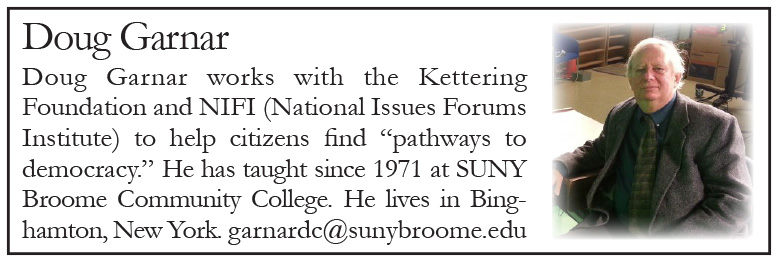Pathways to Democracy: The Christmas Truce
Perhaps the real meaning of the 1914 Christmas Truce is the understanding that whatever our differences are, there is an underlying fundamental common humanity.
Had one been a cultural historian and anthropologist from Planet Bb in the Alpha Centauri Star system, visiting the Earth to do field work in 1492, the great empires of China, the Aztecs, Incas, the Ottomans, the Safavids and the Mughals would have all looked more powerful than the over 350 political units loosely call Europe. By 1914, Europe controlled 84% of the planet. At the same time, Europe had settled down into two rival alliance groups, expecting that sooner than later a war would break out.
In 1910 Norman Angell wrote a very successful book called The Great Illusion. He argued that should war break out it would produce an unprecedented economic/social catastrophe. He assumed that the great statesmen of the age would not leap into the abyss, and if they did the war would be over in a short period of time.
The Germans led the Triple Alliance (Germany, Austro-Hungary, Ottomans) and they counted on the Schlieffen Plan to help win a decisive victory in the West against the French and then turn their armies to the east to defeat the Tsarist Empire of Russia should a war begin A terrorist assassination of the heir to the Austro-Hungarian Empire started the wheels in motion for what became known as the Great War (August 4, 1914) German Kaiser Wilhelm 11 confidently assured the German people that the victorious soldiers would be home Christmas. But the Schlieffen Plan failed and by early fall a static trench front war running from Switzerland to Belgium would emerge, resulting in the deaths of millions. War was no longer politics by other means. It had become hatred by other means. Over a dozen great battles were fought between 1914-18 with little to show but unprecedented death by the “machine gun,” barbed wire, artillery shells and poison gas.
Five peace treaties, the most famous being the Versailles treaty, would conclude the war with the “Allies,” led by the United States, winning the conflict. Yet, twenty years later WW 2 would begin in Poland and go on to result in massive civilian/military casualties, exceeding over 55 million dead, along with victims of genocide on an unprecedented scale, some 6 million Jews and a like number of “racially” sub humans as defined by the Nazis.
A major underlying force in both wars was the power of nationalism. On its worse days nationalism in the 20th century has identified those of a different nationality as the “other” and under the right circumstances has sought to eliminate them.
Despite the carnage of the 20 century and the creation of mass weapons of destruction to this very day, there have been pockets of humanity who have, however briefly, recognized the common humanity of us all. Perhaps one of the most dramatic illustrations of this was the famous “Christmas Truce of 1914.”
On Christmas eve, 1914, German troops began decorating Christmas trees with candles around their trenches near Ypres, Belgium. While singing German Christmas carols, including “Silent Night”. British troops began to reciprocate by singing English Christmas carols. It was a star studded cold night. Troops from both sides began to meet in “No Man’s Land” exchanging small gifts, most notably whisky and cigars. Dead soldiers who had been killed in No Man’s Land days earlier were retrieved to be buried behind the trenches. Soldiers from both sides joined in paying their respects to the fallen soldiers, with some soldiers from both sides reciting the 23rd Psalm. Some soldiers wrote their families about an informal soccer game that was held, with the Germans winning 3-2. During this most unusual Christmas evening, no artillery was fired. In some areas this informal truce continued until New Years Day. An earlier call in the Fall by Pope Benedict XV for a truce went unheeded by the High commands on both sides. But for a brief moment those soldiers who were witnessing a horror beyond comprehension, took matters into their own hands albeit for a short period of time. Two years later on the Eastern Front there was a brief truce between Russian and German troops
The commanding generals on both sides vowed this would never happen again and threatened the death sentence for any soldiers who attempted to repeat the Christmas Truce of 1914. To ensure there would be no repeat truce, artillery barrages were order for each subsequent Christmas until the end of the war.
The events of the Christmas Truce have been captured in songs such as “Snoopy and the Read Baron” and “Christmas in the Trenches.” Perhaps the best known is a book by Stanley Weintraub, Silent Night: The Story of the World War I Christmas Truce. A film, Merry Christmas, about the Christmas Truce was produced in 2005 and was nominated for the best foreign film award at the 78th Academy Awards.
The Christian symbolism of the birth of Christ, the Prince of Peace, is obvious. But in the second half of the 19th century Marx would decry Christianity as the “opiate of the people,” while Nietzsche would proclaim that “God is Dead”. Perhaps the real meaning of the 1914 Christmas Truce is the understanding that whatever our differences are, there is an underlying fundamental common humanity. Virtually all the great religious traditions speak of the need to show love, compassion and empathy to the “other”— an antidote to murderous tribal passions of the modern era.
Shalom to all, Doug Garnar
